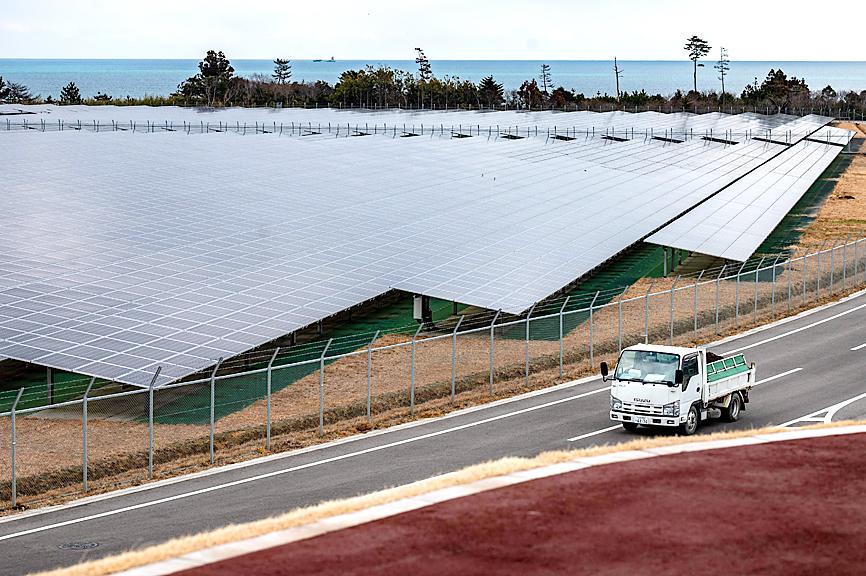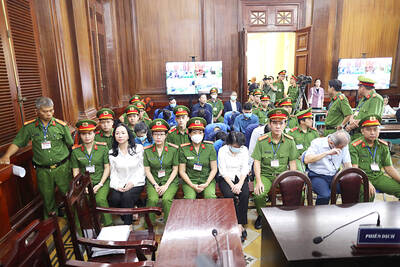Solar farms along once tsunami-ravaged coastlines, green energy “microgrids” and the experimental production of nonpolluting hydrogen: Eleven years after its nuclear nightmare, Japan’s Fukushima Prefecture is investing in a renewable future.
On March 11, 2011, an earthquake unleashed a deadly tsunami on northeastern Japan, triggering a meltdown at the Fukushima Dai-ichi nuclear power plant and forcing mass evacuations.
One year later, Fukushima set a goal of meeting all its energy needs with renewable power by 2040, a policy intended to help residents “reclaim” the place they call home, local officials said.

Photo: AFP
Substantial progress has been made, in part thanks to hefty financial support from the Japanese government.
Renewables accounted for 43 percent of Fukushima’s energy consumption in fiscal 2020, up from just 24 percent in 2011.
However, obstacles remain, from the higher cost for consumers to lingering concern over contamination.
“A strong desire to never see a repeat of such an accident was the most important starting point” for the green energy drive, Fukushima Planning Department Energy Director Noriaki Saito told Agence France-Presse.
A gleaming field of solar panels now lines a coastal stretch north of the stricken power plant, at a site once earmarked for the prefecture’s third nuclear power station, a project abandoned after the tsunami.
Power from the site, which was completed in 2020 and is as big as 25 soccer fields, is used to make hydrogen — a clean fuel when generated with green energy, and one that Japan hopes will help it reach its goal of carbon neutrality by 2050.
Fuel produced at the Fukushima Hydrogen Energy Research Field has so far been used at events including the Tokyo Olympic Games last year, as well as to refill local fuel cell-powered vehicles.
“In the near future, much more renewable energy will come to the grid” in Japan, said Eiji Ohira, an official at the public research body managing the facility.
The site aims to eventually draw renewable energy from the national grid on days when there is surplus production nationally, helping reduce wastage while generating hydrogen, he said.
The prefecture had hydroelectric dams before the tsunami, but wind farms have since been appearing in its mountains, biomass power plants are being constructed and solar fields have sprung up on land abandoned after the tsunami.
However, not everyone in the region has been won over.
Price is still a sticking point, said Apollo Group, a small energy provider in Fukushima that has bolstered its renewable offerings in the past few years.
The price of solar-generated electricity is “a little higher” than conventional power, Apollo CEO Motoaki Sagara said.
“When we explain this to our customers, they often say they prefer cheaper electricity. I feel like the understanding is still not there,” he said.
Public subsidies gave Apollo impetus to switch, but Sagara calls them a “double-edged sword,” as firms like his might come to rely on them and would struggle without.
Another renewables project hoping to win over residents involves “microgrids,” where electricity is produced and consumed in the same place.
Katsurao, a small village near the stricken plant, was evacuated because of radioactive contamination between 2011 and 2016, and now has only 450 residents, less than one-third of its former population.
A former rice field, used to store radioactive materials when workers conducted dangerous early decommissioning work, now hosts a solar farm whose electricity is routed directly to the village.
Katsurao Electric Power vice president Seiichi Suzuki has called the village Japan’s “first autonomous community with a microgrid.”
“The villagers ... expressed a strong desire to live with natural sources of energy” when they returned to their homes following lengthy evacuations, he said.
For now, the solar farm only covers 40 percent of the village’s average yearly electricity needs, and the spectre of the nuclear disaster hangs over other projects.
Some residents oppose a planned biomass power station, fearing that it could produce radioactive emissions if material from contaminated parts of the region is used.

Republican US lawmakers on Friday criticized US President Joe Biden’s administration after sanctioned Chinese telecoms equipment giant Huawei unveiled a laptop this week powered by an Intel artificial intelligence (AI) chip. The US placed Huawei on a trade restriction list in 2019 for contravening Iran sanctions, part of a broader effort to hobble Beijing’s technological advances. Placement on the list means the company’s suppliers have to seek a special, difficult-to-obtain license before shipping to it. One such license, issued by then-US president Donald Trump’s administration, has allowed Intel to ship central processors to Huawei for use in laptops since 2020. China hardliners

DISADVANTAGE: Erin O’Toole, who led the Conservatives during the election campaign in 2021, estimated that the interference cost his party as many as nine legislative seats Canada’s domestic spy agency on Monday concluded that China interfered in the past two elections, an official probe heard, the firmest evidence so far of suspected Chinese meddling in Canadian politics. Canadian Prime Minister Justin Trudeau’s Liberal Party won both the elections, held in 2019 and 2021. Under pressure from opposition lawmakers unhappy about media reports on China’s possible role, Trudeau set up a commission into foreign interference. The commission was shown a slide on Monday containing an extract of a briefing in February last year from the Canadian Security Intelligence Service (CSIS). “We know that the PRC [People’s Republic of China] clandestinely

A top Vietnamese property tycoon was on Thursday sentenced to death in one of the biggest corruption cases in history, with an estimated US$27 billion in damages. A panel of three hand-picked jurors and two judges rejected all defense arguments by Truong My Lan, chair of major developer Van Thinh Phat, who was found guilty of swindling cash from Saigon Commercial Bank (SCB) over a decade. “The defendant’s actions ... eroded people’s trust in the leadership of the [Communist] Party and state,” read the verdict at the trial in Ho Chi Minh City. After the five-week trial, 85 others were also sentenced on

‘DELUSIONAL’: Targeting the families of Hamas’ leaders would not push the group to change its position or to give up its demands for Palestinians, Ismail Haniyeh said Israeli aircraft on Wednesday killed three sons of Hamas’ top political leader in the Gaza Strip, striking high-stakes targets at a time when Israel is holding delicate ceasefire negotiations with the militant group. Hamas said four of the leader’s grandchildren were also killed. Ismail Haniyeh’s sons are among the highest-profile figures to be killed in the war so far. Israel said they were Hamas operatives, and Haniyeh accused Israel of acting in “the spirit of revenge and murder.” The deaths threatened to strain the internationally mediated ceasefire talks, which appeared to gain steam in recent days even as the sides remain far